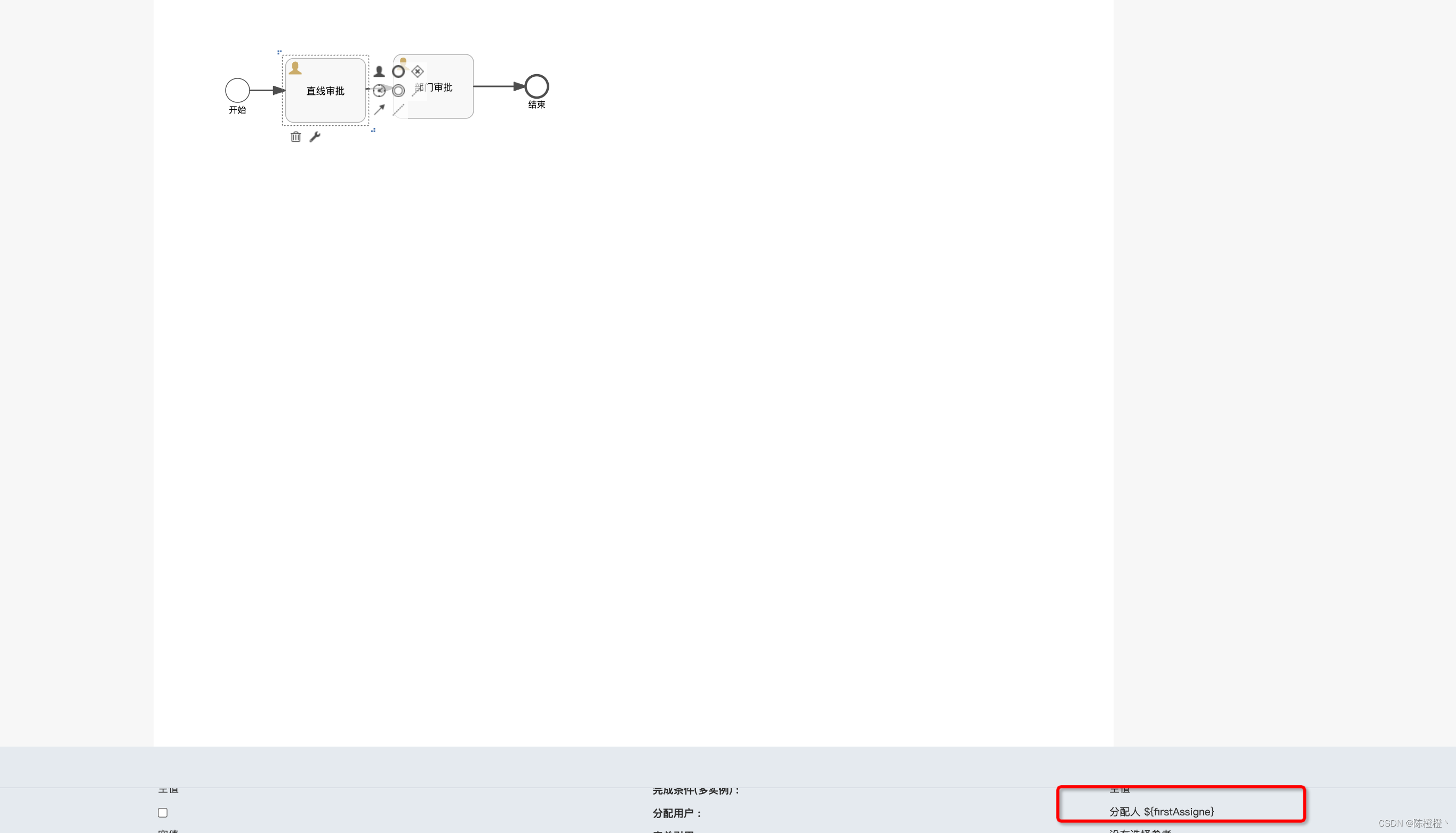前言
在前面我们介绍了Springboot简单使用了foleable以及flowableUI的安装和使用,在之前我们分配任务的处理人的时候都是通过Assignee去指定固定的人的。这在实际业务中是不合适的,我们希望在流程中动态的去解析每个节点的处理人,当前flowable也支持这样去做。
一、 UEL表达式
Flowable使用UEL进行表达式解析。UEL代表Unified Expression Language,是EE6规范的一部分.Flowable支持两种UEL表达式: UEL-value 和UEL-method
- UEL-value:值表达式 Value expression: 解析为一个值。默认情况下,所有流程变量都可以使用。
${userCode}
${isEndWorkFlag == true && isSnedEmailFlag == true}
# 这里userCode可以是任意值,员工号(编码),isEndWorkFlag和isSnedEmailFlag可以是boolean类型的值
- UEL-method:将method方法注入到activiti的processEngineConfiguration的bean中。
${userService.findManagerUserCodeByEmpCode(empCode)}# 这里userService就是我们spring当中的bean,这里先说明一下值表达式,后续整合spring的时候,在补充这块。
我们知道了UEL表达式之后,我们简单测试一下使用
二、使用FlowableUI绘制流程

绘制一个简单的流程,在分配人那里使用UEL表达式去指定节点处理人,绘制完成之后点击下载将流程下载下来,放置项目的resources下,这里有想尝试的可以直接使用如下MyHoliday.bpmn20.xml
<?xml version="1.0" encoding="UTF-8"?>
<definitions xmlns="http://www.omg.org/spec/BPMN/20100524/MODEL" xmlns:xsi="http://www.w3.org/2001/XMLSchema-instance" xmlns:xsd="http://www.w3.org/2001/XMLSchema" xmlns:flowable="http://flowable.org/bpmn" xmlns:bpmndi="http://www.omg.org/spec/BPMN/20100524/DI" xmlns:omgdc="http://www.omg.org/spec/DD/20100524/DC" xmlns:omgdi="http://www.omg.org/spec/DD/20100524/DI" typeLanguage="http://www.w3.org/2001/XMLSchema" expressionLanguage="http://www.w3.org/1999/XPath" targetNamespace="http://www.flowable.org/processdef" exporter="Flowable Open Source Modeler" exporterVersion="6.7.2"><process id="MyHoliday" name="MyHoliday" isExecutable="true"><startEvent id="startEvent1" name="开始" flowable:formFieldValidation="true"></startEvent><userTask id="sid-320C4AED-D9F4-4C53-B2B6-D4ACCBA155F5" name="直线审批" flowable:assignee="${firstAssigne}" flowable:formFieldValidation="true"><extensionElements><modeler:initiator-can-complete xmlns:modeler="http://flowable.org/modeler"><![CDATA[false]]></modeler:initiator-can-complete></extensionElements></userTask><sequenceFlow id="sid-422764E6-61F4-454A-BF08-9CF973E1E67D" sourceRef="startEvent1" targetRef="sid-320C4AED-D9F4-4C53-B2B6-D4ACCBA155F5"></sequenceFlow><userTask id="sid-873E297E-9E6B-4F4E-AF6A-2E085F1806B1" name="部门审批" flowable:assignee="${deptAssigne}" flowable:formFieldValidation="true"><extensionElements><modeler:initiator-can-complete xmlns:modeler="http://flowable.org/modeler"><![CDATA[false]]></modeler:initiator-can-complete></extensionElements></userTask><sequenceFlow id="sid-A0869337-10D3-43BC-90C1-036C9719308E" sourceRef="sid-320C4AED-D9F4-4C53-B2B6-D4ACCBA155F5" targetRef="sid-873E297E-9E6B-4F4E-AF6A-2E085F1806B1"></sequenceFlow><endEvent id="sid-CAB64925-F653-4167-8E12-ED956B723D2E" name="结束"></endEvent><sequenceFlow id="sid-91D96B3A-3408-4504-A23D-8F0C2AFE19A7" sourceRef="sid-873E297E-9E6B-4F4E-AF6A-2E085F1806B1" targetRef="sid-CAB64925-F653-4167-8E12-ED956B723D2E"></sequenceFlow></process><bpmndi:BPMNDiagram id="BPMNDiagram_MyHoliday"><bpmndi:BPMNPlane bpmnElement="MyHoliday" id="BPMNPlane_MyHoliday"><bpmndi:BPMNShape bpmnElement="startEvent1" id="BPMNShape_startEvent1"><omgdc:Bounds height="30.0" width="30.0" x="89.99999731779107" y="149.99999552965178"></omgdc:Bounds></bpmndi:BPMNShape><bpmndi:BPMNShape bpmnElement="sid-320C4AED-D9F4-4C53-B2B6-D4ACCBA155F5" id="BPMNShape_sid-320C4AED-D9F4-4C53-B2B6-D4ACCBA155F5"><omgdc:Bounds height="80.0" width="100.00000000000003" x="164.99999731779107" y="124.99999552965178"></omgdc:Bounds></bpmndi:BPMNShape><bpmndi:BPMNShape bpmnElement="sid-873E297E-9E6B-4F4E-AF6A-2E085F1806B1" id="BPMNShape_sid-873E297E-9E6B-4F4E-AF6A-2E085F1806B1"><omgdc:Bounds height="80.00000000000001" width="100.0" x="299.99999105930357" y="119.99999642372141"></omgdc:Bounds></bpmndi:BPMNShape><bpmndi:BPMNShape bpmnElement="sid-CAB64925-F653-4167-8E12-ED956B723D2E" id="BPMNShape_sid-CAB64925-F653-4167-8E12-ED956B723D2E"><omgdc:Bounds height="28.0" width="28.0" x="464.9999861419205" y="145.9999920725826"></omgdc:Bounds></bpmndi:BPMNShape><bpmndi:BPMNEdge bpmnElement="sid-91D96B3A-3408-4504-A23D-8F0C2AFE19A7" id="BPMNEdge_sid-91D96B3A-3408-4504-A23D-8F0C2AFE19A7" flowable:sourceDockerX="50.0" flowable:sourceDockerY="40.00000000000001" flowable:targetDockerX="14.0" flowable:targetDockerY="14.0"><omgdi:waypoint x="399.94999034668683" y="159.99999473723344"></omgdi:waypoint><omgdi:waypoint x="464.99998600932435" y="159.99999254311274"></omgdi:waypoint></bpmndi:BPMNEdge><bpmndi:BPMNEdge bpmnElement="sid-A0869337-10D3-43BC-90C1-036C9719308E" id="BPMNEdge_sid-A0869337-10D3-43BC-90C1-036C9719308E" flowable:sourceDockerX="50.000000000000014" flowable:sourceDockerY="40.0" flowable:targetDockerX="50.0" flowable:targetDockerY="40.00000000000001"><omgdi:waypoint x="264.9499973177909" y="163.1481439230865"></omgdi:waypoint><omgdi:waypoint x="299.9999910593035" y="161.8499961786801"></omgdi:waypoint></bpmndi:BPMNEdge><bpmndi:BPMNEdge bpmnElement="sid-422764E6-61F4-454A-BF08-9CF973E1E67D" id="BPMNEdge_sid-422764E6-61F4-454A-BF08-9CF973E1E67D" flowable:sourceDockerX="15.0" flowable:sourceDockerY="15.0" flowable:targetDockerX="50.000000000000014" flowable:targetDockerY="40.0"><omgdi:waypoint x="119.94999580774865" y="164.99999552965178"></omgdi:waypoint><omgdi:waypoint x="164.9999973177828" y="164.99999552965178"></omgdi:waypoint></bpmndi:BPMNEdge></bpmndi:BPMNPlane></bpmndi:BPMNDiagram>
</definitions>
三、部署流程
@Testpublic void testDeploy() {//1.获取ProcessEngine 对象ProcessEngine processEngine = ProcessEngines.getDefaultProcessEngine();//2.获取RepositoryServiceRepositoryService repositoryService = processEngine.getRepositoryService();//3.完成流程部署操作Deployment deploy = repositoryService.createDeployment().addClasspathResource("MyHoliday.bpmn20.xml") //关联要部署的流程名称.name("请假流程").deploy(); //部署流程System.out.println("id: " + deploy.getId());System.out.println("name: " + deploy.getName());System.out.println("key: " + deploy.getKey());}
注意:ProcessEngines.getDefaultProcessEngine();该获取方式会去加载resources下的
flowable.cfg.xml文件,该文件为数据库的一些配置以及启动配置信息:
<beans xmlns="http://www.springframework.org/schema/beans"xmlns:xsi="http://www.w3.org/2001/XMLSchema-instance"xsi:schemaLocation="http://www.springframework.org/schema/beans http://www.springframework.org/schema/beans/spring-beans.xsd"><bean id="processEngineConfiguration"class="org.flowable.engine.impl.cfg.StandaloneProcessEngineConfiguration"><property name="jdbcUrl" value="jdbc:mysql://xxxxxx/flowable?allowMultiQueries=true&useUnicode=true&characterEncoding=UTF-8&useSSL=false&serverTimezone=UTC&nullCatalogMeansCurrent=true" /><property name="jdbcDriver" value="com.mysql.cj.jdbc.Driver" /><property name="jdbcUsername" value="xxx" /><property name="jdbcPassword" value="xxx" /><!--是否自动创建表--><property name="databaseSchemaUpdate" value="true" /><!---是否启用异步任务--><property name="asyncExecutorActivate" value="false" /></bean>
</beans>
不想使用该方法的也可以使用之前文章中的示例去进行创建ProcessEngine对象,如下:
@Testpublic void testProcessEngine() {// 获取 ProcessEngineConfiguration 对象ProcessEngineConfiguration configuration = new StandaloneProcessEngineConfiguration();//配置相关的数据库连接信息configuration.setJdbcDriver("com.mysql.cj.jdbc.Driver");configuration.setJdbcUsername("xxxx");configuration.setJdbcPassword("xxxx");configuration.setJdbcUrl("jdbc:mysql://xxxxx/flowable?useUnicode=true&characterEncoding=UTF-8&serverTimezone=Asia/Shanghai");//如果数据库中的表结构不存在就新建configuration.setDatabaseSchemaUpdate(ProcessEngineConfiguration.DB_SCHEMA_UPDATE_TRUE);//构建流程引擎对象ProcessEngine processEngine = configuration.buildProcessEngine();System.out.println("processEngine = " + processEngine);}
启动完成之后:
查询表:ACT_RE_PROCDEF流程定义信息,上篇文章有介绍到flowable表的作用和注释,有兴趣的可以去看看。

这里
ID_:字段表示流程定义ID,可以理解成后续扩展版本控制的时候这个表示不同的版本号,DEPLOYMENT_ID_:表示此次部署的ID
查询表: :ACT_GE_BYTEARRAY 表的资源信息,可以看到我们绘制的xml文件一些信息

四、启动流程
@Testpublic void startTest() {ProcessEngine defaultProcessEngine = ProcessEngines.getDefaultProcessEngine();RuntimeService runtimeService = defaultProcessEngine.getRuntimeService();Map<String, Object> variables = new HashMap<>();//部门处理人指定为张三处理firstAssigne为上述绘制指派人所填写的变量variables.put("firstAssigne", "张三");variables.put("deptAssigne", "李四");//MyHoliday:1:22504就是上面介绍到的 流程定义IDProcessInstance processInstance = runtimeService.startProcessInstanceById("MyHoliday:1:22504", variables);System.out.println("processInstance.getProcessInstanceId() = " + processInstance.getProcessInstanceId());}
启动完成之后:
查询表: ACT_RU_VARIABLE查询我们决策变量。

查询表::ACT_RU_TASK可以看到我们当前流程的任务处理到哪了

五、审批操作
@Testpublic void complete() {ProcessEngine defaultProcessEngine = ProcessEngines.getDefaultProcessEngine();TaskService taskService = defaultProcessEngine.getTaskService();taskService.setAssignee("25007", "张三");taskService.complete("25007");}
完成审批后可以看到act_ru_task表的节点达到部门审批了。

继续审批
@Testpublic void complete01() {ProcessEngine defaultProcessEngine = ProcessEngines.getDefaultProcessEngine();TaskService taskService = defaultProcessEngine.getTaskService();Task task = taskService.createTaskQuery()//流程实例ID很多地方可以拿ACT_RU_EXECUTION表中PROC_INST_ID_或者ACT_RU_TASK中的PROC_INST_ID_等等.processInstanceId("25001").taskAssignee("李四").singleResult();taskService.complete(task.getId());}
六、结束
经过上述操作,该流程已经完成了审批了。我们可以查询ACT_HI_ACTINST看到历史流程实例信息

本篇内容简单的介绍了一下从绘制流程到审批介绍的简单过程,如果有不正确或者不足的地方还恳请各位小伙伴给出一些建议。

)










)




)
![[NLP]LLM---大模型指令微调中的“Prompt”](http://pic.xiahunao.cn/[NLP]LLM---大模型指令微调中的“Prompt”)
